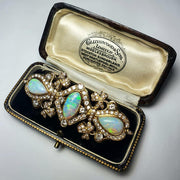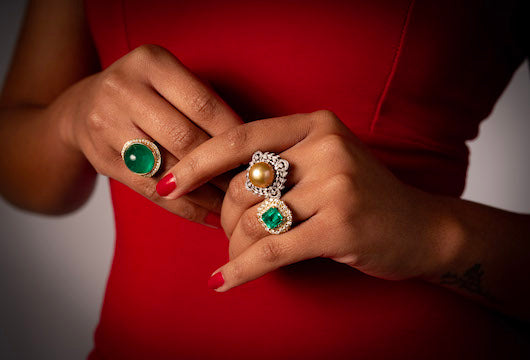Careful evaluation of the stylistic elements of antique pieces can help to determine age and approximate period of origin.
Antique and Vintage Jewelry's Rise in Popularity
Heirloom jewels exhibit intricate, handwrought design, exceptional gems, and a uniqueness that has caught the attention of jewelry collectors everywhere. In the past five years, antique and vintage jewelry has become a force in the industry. As Art Deco engagement rings abound on Instagram, and new websites specializing in estate pieces pop up daily, it has become important to develop a grasp of the different periods and their similarities and differences. Whether you are a consumer seeking to sell or purchase, or a dealer advising a client, it is important to have a general background of common periods and styles. Some periods are more collectible (and thus valuable) than others, so being able to correctly estimate the age of a piece before purchase is critical. While many periods slightly overlap, the information below provides meaningful distinctions between the eras of fine jewelry design and identifying characteristics for estate and vintage jewelry.
Georgian Period (Early 18th to mid-19th Century)
The Georgian Period spans over a century. Known as such because it was the time when England was ruled by the four “Georges”, the jewelry of this era was handmade and frequently featured motifs of nature coupled with fanciful ribbons and bows in its designs. A popular stylistic element of the period was jewelry en tremblant – pieces that moved with the wearer and sparkled warmly in the low candlelight of the time. Foil backing was also used frequently to increase the sparkle of gems. If you purchase Georgian pieces today, it is important that you never get the pieces wet as it damages the foil backing and hurts the value. Pieces from this period are rare and highly sought after by collectors.
Victorian Period (Mid 19th - early 20th Century)
As its namesake implies, the Victorian era began with Queen Victoria’s reign in 1837. Her rule of Great Britain spanned such a long segment of time that the period is divided into three distinct movements: The Romantic Period, The Gothic Revival Movement, and the late Victorian Era (after the death of Prince Albert), when mourning jewelry became so popular.
The Romantic Period and Gothic Revival Movements
Jewelry from the Romantic Period was for the most part light and delicate, frequently featuring floral designs and airy scrollwork. Gothic Revival pieces heralded a nostalgia for the aesthetics of the Middle Ages and the Renaissance, with an emphasis on enamelwork and a return to a “bigger is better” mindset. The pieces from this period frequently contain multiple large colored gems interspersed with diamonds and heavy, intricate goldwork.

A Victorian clasp for a book chain pendant, circa 1870-1880.
The Late Victorian Era (or the Era of Mourning)
When Prince Albert died in 1861, Queen Victoria lost the love of her life and a more subdued sentiment was echoed in almost all elements of Victorian life. Mourning jewelry became exceedingly popular during this time. Brooches and other pieces were frequently carved from black onyx and Whitby jet, and were frequently adorned with small delicate seed pearls and the names of those lost. Jewelry from this period was perhaps more important as a tribute to lost love than adornment.
The Arts and Crafts and Art Nouveau Movements (late 19th – early 20th Century)
While these periods were concurrent, running from approximately the 1880’s to the 1920’s, their styles are distinct in many important ways. The Arts and Crafts movement came about in response to the rise of mass production and mechanization at this time. In Arts and Crafts pieces, the primary emphasis was upon the work of the artist and simple, honest, hand-made craftsmanship. More modest materials like beaten copper and cabochon stones were frequently used, and diamonds were almost never seen. Elements of nature also featured strongly in Arts and Crafts design.
Art Nouveau, on the other hand, also embraced the influence of natural elements, but in a more dramatic, colorful way. Emphasis was placed upon the overall composition of the piece, and dramatic, skillful interweaving of color in undulating, curving lines was often seen in representative pieces by famous jewelers like Louis Comfort Tiffany and Rene Lalique. Perhaps the biggest difference between the two styles is that while the Arts and Crafts movement focused on the honesty and simplicity of nature, Art Nouveau creations centered on the heightening of its drama.
Edwardian and Belle Epoch (early 20th Century)
Light, delicate chains embellished with stunningly intricate filigree work and sparkling diamonds – the jewelry of these eras is the stuff of which Downton Abbey dreams are made. A key element shared by Belle Epoch and Edwardian jewelry were the advances made in diamond faceting. New cutting techniques increased diamond’s sparkle and brilliance, and designers were eager to highlight these enhancements in their creations. As a result, diamonds took center stage, and while gold was still used platinum became more and more prevalent. The metal was strong enough to support lacy openwork designs without failure – in fact, many of these delicate, web-like creations still exist today in pristine condition due to the integrity of the dense metal.
Soft, feminine garlands and swags dominated the designs of pieces from this era, but geometric elements are also sometimes seen in necklaces, earrings, rings, and bracelets of the period. Both natural pearls and seed pearls were implemented with regularity to make elegant sautoirs, negligee pendants, and pearl chokers. Famous designers like Cartier, Van Cleef & Arpels, and Boucheron made their names synonymous with high jewelry at this time, and their pieces continue to be highly coveted today.
Art Deco Period
The Art Deco period of jewelry design is virtually synonymous with “The Roaring Twenties”. The boundaries of women’s roles in society, and the attire they wore, were being pushed to the limits, and jewelry design was no exception. The use of platinum and diamonds continued, but was now coupled with colored stones to create bold, geometric works of art. Jewels in every color – ruby, emerald, sapphire were celebrated and frequently featured as center stones, while peridot, garnet, citrine, aquamarine, jade, coral, and onyx were used to create strong contrast. Composition was everything in Art Deco jewelry – pieces were carefully thought out and meticulously crafted to create gorgeous juxtapositions of shape and color.
Emerald and step-cut cut stones ruled the day for faceted gems of all varieties, and unusual geometric shapes for diamond accent stones emerged as well. Diamonds were being cut into novel triangular, half-moon, and square cuts to draw attention to center stones and add to the geometric arrangement of pieces.
A critical element of jewelry identification for jewels of this area is the predominance of synthetic gems. Synthetics were common, readily available, and widely accepted. It is important that one never assumes the genuineness of colored stones from this era, particularly in the case of small, calibrated accent stones.
Cartier’s chief designer of the time - Charles Jacqueau – is renowned as one of the great pioneers of the Art Deco style. Jacqueau’s influence is clearly apparent in the heavy use of Asian and Middle Eastern influences and the emergence of Egyptian revival as a strong subset of Art Deco design.
Other popular designers of this period include Boivin, Belperron, Chaumet, Mauboussin, Mellerio, Georg Jensen, LaCloche, Templier, Tiffany, Marchak, J.E. Caldwell, and Fouquet.
A Brief Caution Regarding Replica Pieces
With all eras outlined above, replicas and marriages of old and new pieces abound. While there is nothing intrinsically wrong with repurposing a damaged piece as long as any modifications are disclosed, a wise buyer will carefully compare stylist markers for antique and vintage jewelry to ensure that the piece they are purchasing is unaltered and authentic. A Victorian brooch will never have a rolling closure on its pin, and Georgian pieces are not set with brilliant cut diamonds. Choose carefully. Whatever the era of the piece you desire, a careful eye and attention to detail will help ensure that your purchase is a wise one.



